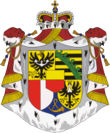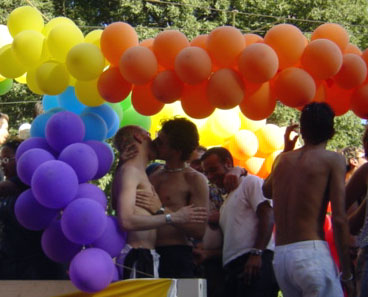Difference between revisions of "Saterno"
Ganchelkas (Talk | contribs) (→Same-sex marriage in Saterno) |
Ganchelkas (Talk | contribs) (→Same-sex marriage in Saterno) |
||
| Line 66: | Line 66: | ||
| − | + | [[Image:Carro gay Milano 2003.jpg|right|thumb|368px|A Gay Pride march]] | |
| − | [[Image:Carro gay Milano 2003.jpg| | + | |
The same-sex marriage law did not permit adoption by same-sex partners; and as birth within a same-sex marriage did not imply affiliation, the same-sex spouse of the biological parent had no way to become the legal parent. On September 250, 2003 a proposal to permit adoption was passed by the Saternoi Council with a majority of 1 vote, thereby enabling legal co-parenting by same-sex couples. | The same-sex marriage law did not permit adoption by same-sex partners; and as birth within a same-sex marriage did not imply affiliation, the same-sex spouse of the biological parent had no way to become the legal parent. On September 250, 2003 a proposal to permit adoption was passed by the Saternoi Council with a majority of 1 vote, thereby enabling legal co-parenting by same-sex couples. | ||
Revision as of 16:32, 26 May 2006
| |||||
| Motto: Power comes through culture. | |||||
| Region | Nasicournia | ||||
| Capital | Saternoi City | ||||
| Largest city | Maladon | ||||
| Official language(s) | English, French, Dutch | ||||
| Government Head of State
Governor-General Prime Minister |
Ganchelkean Protectorate Emperor Geerhardt I Charlotte of Ganchelkas Stephen Thompson | ||||
| Independence | None (Ganchelkean Protectorate) | ||||
| Population • 2005 est. |
3.946 billion | ||||
| Stats: NSEconomy Pipian XML | |||||
|---|---|---|---|---|---|
Saterno, known officially as the Saternoi Protectorate or more commonly referred to as the Protectorate of Saterno, is a nation in the region of Nasicournia bordered by Nimarci, Tertio and Stoned Smurfs. Saterno is a parliamentary democracy with a constitutional monarchy, ruled by the Emperor of Ganchelkas. Saterno is a Ganchelkean Protectorate, which means that the Imperial Confederation of Ganchelkas exercises some control over its policies, while allowing Saterno a large degree of autonomy in all other fields. In practice, however, Saterno functions as an independent nation.
Saterno is trilingual and multicultural nation; English, French and Dutch are official languages. It is a highly developed, and a technologically advanced and industrialized nation, its diversified economy relies heavily on an abundance of natural resources and on trade. Although it is a secular state, Saterno is predominantly Christian.
Government and Politics

The Governor-General acts as the Emperor's vice-regal representative in Saterno and is often viewed as the de facto Head of State. Princess Charlotte of Ganchelkas was appointed Governor-General by imperial decree, with the advice and consent of the Saternoi Council, on the May 24, 2006. Her first act, in conformity with the laws of Saterno, was to dissolve the Saternoi Council on May 25, 2006, following the rejection of a motion of confidence in the Council of Ministers on May 21, 2006, and call a General Election.
Legislative power is vested in the Saternoi Council, a unicameral legislature of 200 members elected directly by the people. General Elections are called by the Governor-General when the Prime Minister so advises, or when a motion of confidence is rejected or a motion of no confidence is adopted by the Saternoi Council, and must occur every three years or less.
Executive power is exercised by the Governor-General and the Council of Ministers, although the former has a largely ceremonial function. The Council of Ministers consists of a Prime Minister and ten other Ministers. The position of Prime Minister, Saterno's Head of Government, belongs to the leader of the political party that obtains a plurality of seats, or the leader of the coalition that can obtain the confidence of a majority in the Saternoi Council.
The Prime Minister and the other Ministers are formally appointed by the Governor-General. However, the Prime Minister chooses the other members of the Council of Ministers and the Governor-General, by convention, respects the Prime Minister's choices. The Council of Ministers is traditionally drawn from the members of the Prime Minister's coalition, but there have also been many apolitical Ministers throughout the history of Saterno. The Prime Minister exercises a great deal of political power, especially in the appointment of other officials within the government and Public Service and in the decision-making process.
Stephen Thompson (Liberal Party) has served as Prime Minister since November 6, 2005. His Government was forced to resign after the rejection of a motion of confidence by the Saternoi Council on May 21, 2006. He asked the confidence of the Saternoi Council as a result of his Government's failure to reach a compromise on pensions and welfare reform. The General Election will be held on Sunday June 2, 2006.
Saterno has five main political parties today: the Liberal Party, the Socialist Party, the Christian-Democratic Party, the Green Party and the Saternoi Bloc. The current government is formed by the Liberal Party, the Socialist Party and the Green Party. There are many smaller parties, some of which are also represented in the Saternoi Council, and some of which have no current representation in the Saternoi Council.
Same-sex marriage in Saterno
On April 25, 2001, Saterno became one of the first countries in the world to legally recognise same-sex marriage. In many nations, same-sex marriages are known as civil uions or civil partnerships, but in Saterno same-sex marriages have the exact same legal statute, including terminology, as any other civil marriage. This was achieved when the Christian-Democrats were not in power. Saterno also allows the marriages of foreign same-sex couples, even if their country of origin doesn't allow these unions, making Saterno a popular destination for same-sex couples that want to get married.
Since the legalisation of same-sex marriage, approximately 175,000 same-sex couples were married. This constitutes 1.5 percent of the total number of marriages in Saterno during that period. Two thirds of the married couples were gay male couples; the remainder were lesbian couples.
The same-sex marriage law did not permit adoption by same-sex partners; and as birth within a same-sex marriage did not imply affiliation, the same-sex spouse of the biological parent had no way to become the legal parent. On September 250, 2003 a proposal to permit adoption was passed by the Saternoi Council with a majority of 1 vote, thereby enabling legal co-parenting by same-sex couples.
((More information on the state of gay rights in Saterno will be added shortly.))
Military
The armed forces of Saterno are known as the Saternoi Armed Forces. Their Commander-in-Chief is the Ganchelkean Emperor, Emperor Geerhardt I and they are managed by the Ministry of Defence. The Saternoi Armed Forces are under civilian control, they are ultimately accountable to the Council of Ministers (in wartime) and the Saternoic Council (in peacetime).
The Saternoi Armed Forces are charged with protecting the territorial integrity and political independence of Saterno, promoting Saterno's wider security interests, and supporting international peacekeeping efforts. The Saternoi Protectorate fields one of the most powerful and comprehensive military forces in Nasicournia. In recent years, controversy has arisen on Saterno's large Nuclear Defence Programme, and the plans to group all air, sea and land based nuclear forces in one component to be known as the Nuclear Defence Forces.






